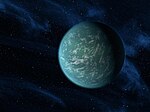HIP 57274 d
| Discovery | |
|---|---|
| Discovered by | Fischer et al. |
| Discovery date | 28 December 2011 |
| radial velocity | |
| Orbital characteristics | |
| 1.01 AU (151,000,000 km) | |
| Eccentricity | 0.27 (± 0.05)[1] |
| 413.7 (± 8.5)[1] d | |
| Star | HIP 57274 |
| Physical characteristics | |
| ~9 R🜨 | |
| Mass | 0.527 (± 0.025)[1] MJ (167.5 ME) |
| Temperature | 167 K (−106 °C; −159 °F)[2] |
HIP 57274 d is an exoplanet orbiting the K-type main sequence star HIP 57274 about 84.5 light-years (26 parsecs, or nearly 8.022×1016 km) from Earth in the constellation Cetus. It orbits within the outer part of its star's habitable zone, at a distance of 1.01 AU. The exoplanet was found by using the radial velocity method, from radial-velocity measurements via observation of Doppler shifts in the spectrum of the planet's parent star.
Characteristics
Mass, radius and temperature
HIP 57274 d is a gas giant, a planet that has a radius and mass close to that of the gas giants Jupiter and Saturn. It has a temperature of 167 K (−106 °C; −159 °F). It has an estimated mass of around 0.527 MJ (167 ME), and a potential radius of around 9 R🜨 based on its mass, since it is slightly more massive than Saturn.
Host star
The planet orbits a (K-type) star named HIP 57274, orbited by a total of three planets. The star has a mass of 0.73 M☉ and a radius of 0.68 R☉. It has a surface temperature of 4640 K and is 7 billion years old. In comparison, the Sun is about 4.6 billion years old[3] and has a surface temperature of 5778 K.[4]
The star's apparent magnitude, or how bright it appears from Earth's perspective, is 8.96. Therefore, HIP 57274 is too dim to be seen with the naked eye, but can be seen with good binoculars.
Orbit
HIP 57274 d orbits its star every 432 days at a distance of 1.01 AU. This is very similar to that of Earth's orbital period and distance.
Habitability
HIP 57274 d resides in the outer part of circumstellar habitable zone of the parent star. The exoplanet, with a mass of 0.527 RJ, is too massive to be rocky, and because of this the planet itself may not be habitable. Hypothetically, large enough moons, with a sufficient atmosphere and pressure, may be able to support liquid water and potentially life.
For a stable orbit the ratio between the moon's orbital period Ps around its primary and that of the primary around its star Pp must be < 1/9, e.g. if a planet takes 90 days to orbit its star, the maximum stable orbit for a moon of that planet is less than 10 days.[5][6] Simulations suggest that a moon with an orbital period less than about 45 to 60 days will remain safely bound to a massive giant planet or brown dwarf that orbits 1 AU from a Sun-like star.[7] In the case of HIP 57274 d, the moon's orbit would have to be roughly 40 days to support a stable orbit.
Tidal effects could also allow the moon to sustain plate tectonics, which would cause volcanic activity to regulate the moon's temperature[8][9] and create a geodynamo effect which would give the satellite a strong magnetic field.[10]
To support an Earth-like atmosphere for about 4.6 billion years (the age of the Earth), the moon would have to have a Mars-like density and at least a mass of 0.07 ME.[11] One way to decrease loss from sputtering is for the moon to have a strong magnetic field that can deflect stellar wind and radiation belts. NASA's Galileo's measurements hints large moons can have magnetic fields; it found that Jupiter's moon Ganymede has its own magnetosphere, even though its mass is only 0.025 ME.[7]
See also
References
- ^ a b c "Planet HIP 57274 d". Extrasolar Planets Encyclopaedia. Retrieved 17 July 2015.
- ^ "Open Exoplanet Catalogue - HIP 57274 D".
- ^ Fraser Cain (16 September 2008). "How Old is the Sun?". Universe Today. Retrieved 19 February 2011.
- ^ Fraser Cain (September 15, 2008). "Temperature of the Sun". Universe Today. Retrieved 19 February 2011.
- ^ Kipping, David (2009). "Transit timing effects due to an exomoon". Monthly Notices of the Royal Astronomical Society. 392 (1): 181–189. arXiv:0810.2243. Bibcode:2009MNRAS.392..181K. doi:10.1111/j.1365-2966.2008.13999.x. S2CID 14754293.
- ^ Heller, R. (2012). "Exomoon habitability constrained by energy flux and orbital stability". Astronomy & Astrophysics. 545: L8. arXiv:1209.0050. Bibcode:2012A&A...545L...8H. doi:10.1051/0004-6361/201220003. ISSN 0004-6361. S2CID 118458061.
- ^ a b Andrew J. LePage. "Habitable Moons:What does it take for a moon — or any world — to support life?". SkyandTelescope.com. Archived from the original on 2012-04-06. Retrieved 2011-07-11.
- ^ Glatzmaier, Gary A. "How Volcanoes Work – Volcano Climate Effects". Archived from the original on 23 April 2011. Retrieved 29 February 2012.
- ^ "Solar System Exploration: Io". Solar System Exploration. NASA. Archived from the original on 16 December 2003. Retrieved 29 February 2012.
- ^ Nave, R. "Magnetic Field of the Earth". Retrieved 29 February 2012.
- ^ "In Search Of Habitable Moons". Pennsylvania State University. Retrieved 2011-07-11.



